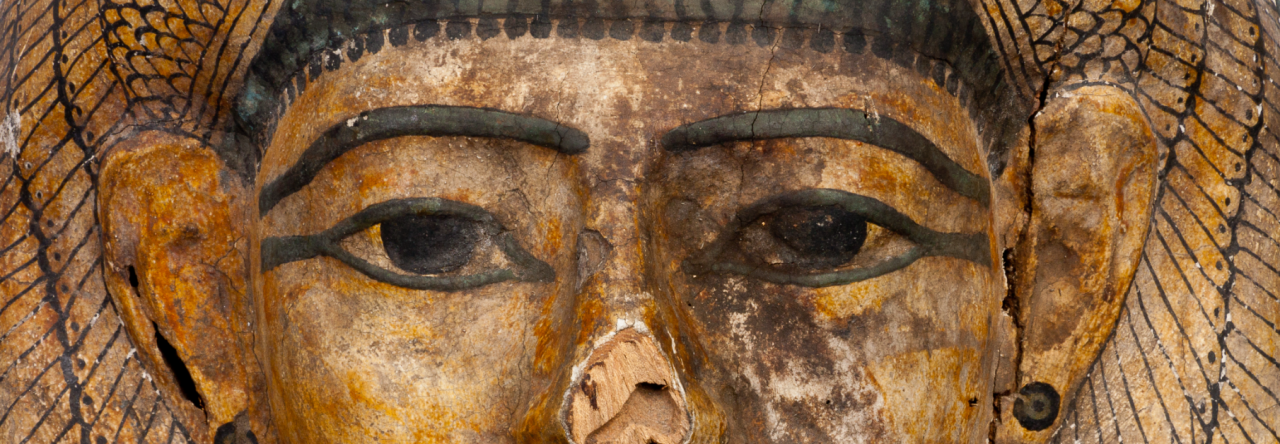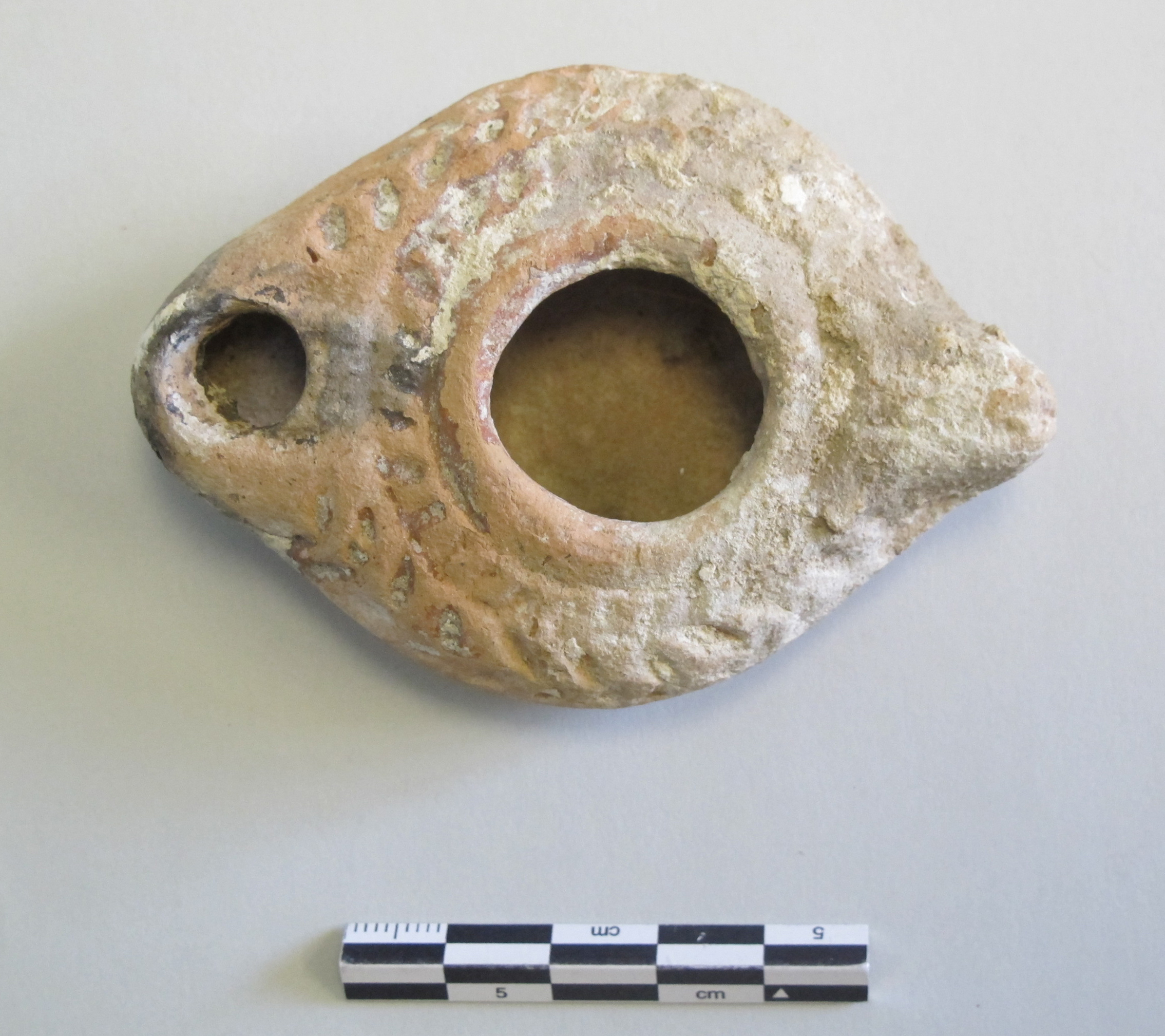For a 3D model made by the Virtual Curation Lab at Virginia Commonwealth University, see https://skfb.ly/orATX
Lamp with wreath relief
AWG0000.03.10
Roman or Levantine
3rd-5th century CE
Material: Ceramic
Weight: 51g
Dimensions: 8.2 cm across, 5.5 cm at widest point, 2.3 cm high, 0.6 mm thick, 7 cm diameter of central cutout
Condition: Fair-orange clay layer with traces of matte red slip and accretions in the crevices, slight crack on the underside, obvious wear
Provenance: Unknown
Source/donor: Unknown
Date of acquisition: Unknown
Research by: Julia Berutti ‘23, Amy Nicholas ‘11
Detailed description of form/shape:
The lamp is made of orange clay, but traces of matte red slip remain in many areas on its surface. There also exist some accretions in the crevices. It is a simple, ovoid shape that is pointed on both ends and bears a larger, open hole in the center. There is a small stub handle protruding off the back. Around the central hole is a ring, followed by a relief decoration.
Detailed description of decoration:
A relief decoration surrounds the central ring, consisting of three concentric rings. The first, closest to the center cut-out, lacks any distinguishable relief. The middle ring bears a ring of diagonal hatch lines, while the outermost ring bears two rows of similar hatch lines, aligning with the center ring to form multiple layers of a zigzagging relief. The general effect achieved is an appearance similar to that of a wreath.
Comparanda:
For general shape and similar mold type, compare lamps in the Milwaukee Public Museum (A15856/5253, A15855/5253, N18525/22446, A15852/5253, A15854/5253, and A58655/28902), as well as RSP9 and RSP10 in the RomQ online lamp reference collection. For a very close parallel from Bet-Shean in Israel, see Hadad 1997, fig. 7. Lamps with similar shapes and mold types have been found throughout the eastern Mediterranean and outer regions.
Discussion:
This lamp style, with its round, enclosed center, long, protruding nozzles, and handle, is reminiscent of many other Roman lamps across space and time. However, its most striking feature is distinctly Levantine. The large “filler hole” in the center characterizes it as likely from the region of modern-day Israel, Jordan, Lebanon, and Syria (Da Costa 177). Determining where specifically in the region artifacts come from is difficult for art historians without archeological context, as the area is home to several strong cultural influences. It is not uncommon to find artifacts that originate from the ancient Levant using methods or materials from the West but with decorative elements from the East, especially with newer artifacts (“Ancient Levantine”).
The relief decoration possibly depicts a wreath or garland. In Roman visual culture, wreaths could symbolize a number of things, such as victory, loyalty, dedication, memory, completeness, perfection, wholeness, and time, among others. Wreaths were used during weddings, festivals, rituals, funerals, and as demonstrations of sovereignty when worn by leaders (Gavrilović et. al. 2012, 342).
Very close comparanda, with similar shape and wreath relief, come from excavations at Bet Shean (Hadad 1997, figs. 7-8). This kind of lamp, which the author refers to as “Type 7,” was one of the most frequently found at Bet Shean. These lamps were made of orange, brown, or grey clay. The clay color is one of the identifiers for this lamp type, as is the slip and poor firing quality. These lamps are frequently found in northern Palestine (Hadad 1997, 154-156).
Bibliography:
“Ancient Lamps - Catalogue 3.” RomQ Reference Collection. Accessed October 26, 2021. http://www.romulus2.com/lamps/lampcat/lampcat3.shtml#syro.
De Costa, Emily. 2012. “Shining a Light on Shifting Frontiers: Cultural Uses of Ceramic Lamps during Late Antiquity.” In Shifting Cultural Frontiers in Late Antiquity, edited by David Brakke and Deborah Deliyannis, 167-180. Burlington, VT: Ashgate.
Gavrilović, Dragana , Emilija Nikolić, and Jelena Anđelković Grašar. 2012. “Wreath - Its Use and Meaning in Ancient Visual Culture.” Religion and Tolerance: Journal of the Center for Empirical Researches on Religion 18: 341–58.
Hadad, Shulamit. 1997. “Oil Lamps from the Third to the Eighth Century C. E. at Scythopolis-Bet Shean.” Dumbarton Oaks Papers 51: 147–88. https://doi.org/10.2307/1291764.
“Lamp Classifications.” Milwaukee Public Museum. Accessed October 4, 2021. https://www.mpm.edu/research-collections/anthropology/anthropology-collections-research/mediterranean-oil-lamps/lamp-classifications.
The Art Institute of Chicago. “Ancient Levantine.” Accessed October 26, 2021. https://www.artic.edu/artists/74893/ancient-levantine.


